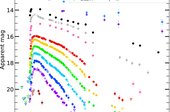 IIA MRIDWEEKA SINGH
IIA MRIDWEEKA SINGHA study in scarlet I. Photometric properties of a sample of intermediate-luminosity red transients
We investigate the photometric characteristics of a sample of intermediate-luminosity red transients (ILRTs), a class of elusive objects with peak luminosity between that of classical novae and standard supernovae. Our goal is to provide a stepping stone in the path to reveal the physical origin of such events, thanks to the analysis of the datasets collected.
Methods. We present the multi-wavelength photometric follow-up of four ILRTs, namely NGC 300 2008OT-1, AT 2019abn, AT 2019ahd, and AT 2019udc. Through the analysis and modelling of their spectral energy distribution and bolometric light curves, we inferred the physical parameters associated with these transients.
Results. All four objects display a single-peaked light curve which ends in a linear decline in magnitudes at late phases. A flux excess with respect to a single blackbody emission is detected in the infrared domain for three objects in our sample, a few months after maximum. This feature, commonly found in ILRTs, is interpreted as a sign of dust formation. Mid-infrared monitoring of NGC 300 2008OT-1 761 days after maximum allowed us to infer the presence of ∼10−3–10−5 M⊙ of dust, depending on the chemical composition and the grain size adopted. The late-time decline of the bolometric light curves of the considered ILRTs is shallower than expected for 56Ni decay, hence requiring an additional powering mechanism. James Webb Space Telescope observations of AT 2019abn prove that the object has faded below its progenitor luminosity in the mid-infrared domain, five years after its peak. Together with the disappearance of NGC 300 2008OT-1 in Spitzer images seven years after its discovery, this supports the terminal explosion scenario for ILRTs. With a simple semi-analytical model we tried to reproduce the observed bolometric light curves in the context of a few solar masses ejected at few 103 km s−1 and enshrouded in an optically thick circumstellar medium.
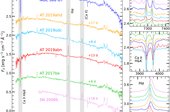 IIA MRIDWEEKA SINGH
IIA MRIDWEEKA SINGHA study in scarlet II. Spectroscopic properties of a sample of intermediate-luminosity red transients
We investigate the spectroscopic characteristics of intermediate-luminosity Red Transients (ILRTs), a class of elusive objects with peak luminosity between that of classical novae and standard supernovae. Our goal is to provide a stepping stone in the path to unveiling the physical origin of these events based on the analysis of the collected datasets.
Methods. We present the extensive optical and near-infrared (NIR) spectroscopic monitoring of four ILRTs, namely NGC 300 2008OT-1, AT 2019abn, AT 2019ahd and AT 2019udc. First we focus on the evolution of the most prominent spectral features observed in the low-resolution spectra. We then present a more detailed description of the high-resolution spectrum collected for NGC 300 2008OT-1 with the Very Large Telescope equipped with UVES. Finally, we describe our analysis of late-time spectra of NGC 300 2008OT-1 and AT 2019ahd through comparisons with both synthetic and observed spectra.
Results. Balmer and Ca lines dominate the optical spectra, revealing the presence of slowly moving circumstellar medium (CSM) around the objects. The line luminosity of Hα, Hβ, and Ca II NIR triplet presents a double peaked evolution with time, possibly indicative of interaction between fast ejecta and the slow CSM. The high-resolution spectrum of NGC 300 2008OT-1 reveals a complex circumstellar environment, with the transient being surrounded by a slow (∼30 km s−1) progenitor wind. At late epochs, optical spectra of NGC 300 2008OT-1 and AT 2019ahd show broad (∼2500 km s−1) emission features at ∼6170 Å and ∼7000 Å which are unprecedented for ILRTs. We find that these lines originate most likely from the blending of several narrow lines, possibly of iron-peak elements.
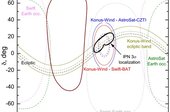 IIA ANUPAMA, G. C
IIA ANUPAMA, G. CMultiwavelength analysis of AT 2023sva: a luminous orphan afterglow with evidence for a structured jet
We present multiwavelength analysis of ZTF23abelseb (AT 2023sva), an optically discovered fast-fading ( mag in d), luminous ( mag), and red ( mag) transient at with accompanying luminous radio emission. AT 2023sva does not possess a -ray burst (GRB) counterpart to an isotropic equivalent energy limit of erg, determined through searching -ray satellite archives between the last non-detection and first detection, making it the sixth example of an optically discovered afterglow with a redshift measurement and no detected GRB counterpart. We analyse AT 2023sva’s optical, radio, and X-ray observations to characterize the source. From radio analyses, we find the clear presence of strong interstellar scintillation (ISS) 72 d after the initial explosion, allowing us to place constraints on the source’s angular size and bulk Lorentz factor. When comparing the source sizes derived from ISS of orphan events to those of the classical GRB population, we find orphan events have statistically smaller source sizes. We also utilize Bayesian techniques to model the multiwavelength afterglow. Within this framework, we find evidence that AT 2023sva possesses a shallow power-law structured jet viewed slightly off-axis () just outside of the jet’s core opening angle (). We determine this is likely the reason for the lack of a detected GRB counterpart, but also investigate other scenarios. AT 2023sva’s evidence for possessing a structured jet stresses the importance of broadening orphan afterglow search strategies to a diverse range of GRB jet angular energy profiles, to maximize the return of future optical surveys.
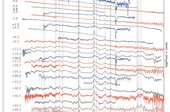 IIA SAHU, D. K
IIA SAHU, D. KSN 2021foa: the bridge between SN IIn and Ibn
We present the long-term photometric and spectroscopic analysis of a transitioning SN IIn/Ibn from –10.8 d to 150.7 d post V-band maximum. SN 2021foa shows prominent He i lines comparable in strength to the H line around peak, placing SN 2021foa between the SN IIn and SN Ibn populations. The spectral comparison shows that it resembles the SN IIn population at pre-maximum, becomes intermediate between SNe IIn/Ibn, and at post-maximum matches with SN IIn 1996al. The photometric evolution shows a precursor at –50 d and a light curve shoulder around 17 d. The peak luminosity and colour evolution of SN 2021foa are consistent with most SNe IIn and Ibn in our comparison sample. SN 2021foa shows the unique case of an SN IIn where the narrow P-Cygni in H becomes prominent at 7.2 d. The H profile consists of a narrow (500–1200 km s) component, intermediate width (3000–8000 km s) and broad component in absorption. Temporal evolution of the H profile favours a disc-like CSM geometry. Hydrodynamical modelling of the light curve well reproduces a two-component CSM structure with different densities ( r– r), mass-loss rates (10–10 M yr) assuming a wind velocity of 1000 km s and having a CSM mass of 0.18 M. The overall evolution indicates that SN 2021foa most likely originated from an LBV star transitioning to a WR star with the mass-loss rate increasing in the period from 5 to 0.5 yr before the explosion or it could be due to a binary interaction.
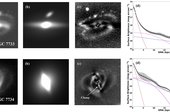 IIA SAILI KESHRI
IIA SAILI KESHRIUnveiling the kinematics of a central region in the triple-AGN host NGC 7733-7734 interacting group
We present a detailed study of the interacting triple active galactic nuclear system, NGC 7733-34, focusing on stellar kinematics, ionised gas characteristics, and star formation within the central region and stellar bars of both galaxies. We performed a comprehensive analysis using archival data from MUSE, HST/ACS, and DECaLS, complemented with observations from UVIT and IRSF. We identified a disc-like bulge in both NGC 7733 and NGC 7734 through a 2D decomposition. A central nuclear structure, with a semi-major axis of ∼1.113 kpc, was detected in NGC 7733 via a photometric and kinematic analysis, confirmed by the strong anticorrelation between V/σ and h3, indicative of circular orbits in the centre. NGC 7734 lacks a distinct nuclear structure. The presence of a disc-like bulge results in an anti-correlation between V/σ and h3, along with diffuse light. However, it does show higher central velocity dispersion, possibly attributed to an interaction with a smaller clump, which is likely a fourth galaxy within the system. Both galaxies demonstrate ongoing star formation, evidenced by FUV and Hα observations. NGC 7734 shows recent star formation along its bar, while NGC 7733 experiences bar quenching. The star formation rate (SFR) analysis of NGC 7734 reveals that the bar region’s SFR dominates the galaxy’s overall SFR. Conversely, in NGC 7733, the lack of star formation along the bar and the presence of a Seyfert 2 active galactic nucleus (AGN) at the galaxy centre suggest the possibility of link among both. However, this would not affect the galaxy’s overall star formation. Our findings provide valuable insights into the stellar and gas kinematics, star formation processes, and AGN feedback mechanisms in interacting galaxies hosting stellar bars.
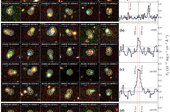 IIA RAVI JOSHI
IIA RAVI JOSHIBaryonic ecosystem in galaxies (BEINGMgII): I. host galaxies of ultra-strong Mg II absorbers in the Subaru Hyper Suprime-Cam Survey
Context. We study the galaxies hosting ultra-strong Mg II (USMgII) absorbers at small impact parameters of ∼2″ (5‑20 kpc) spanning a redshift range of 0.4 ≤ z ≤ 1.7 using deep high-resolution images from the Hyper Suprime-Cam Subaru Strategic Survey and spectra from the Sloan Digital Sky Survey (SDSS). Aims. Our aim is to explore the physical origin of the USMgII absorbers and characterize the associated galaxies. Methods. We performed a galaxy spectral energy distribution (SED) fitting using optical and near-IR multiband data to identify potential absorber host galaxies. Further, we searched for the [O II] nebular emission line from absorber galaxies in the SDSS fiber spectra. Results. From a total of 418 USMgII absorbers with W2796 ≥ 3 Å along 412 quasar sight lines, we detected 50 galaxies based on [O II] λλ3727, 3729 nebular emission detected at the ≥2σ level. Utilizing the [O II] emission from the stacked spectrum and employing the best-fit galaxy SED template, we further identified 86 galaxies, leading to a total of 136 bona fide USMgII galaxies. With a prerequisite of having a minimum of four HSC passbands available, we found a detection rate of ∼38% at an average impact parameter of 11.4 kpc. We find that galaxies hosting USMgII systems are typically star-forming main sequence galaxies, with 21% exhibiting a starburst nature. The non-zero [O II] emission along the "clear" sight lines, with no stellar counterpart, indicates that the USMgII absorbers may likely emanate from the unseen faint galaxies near the quasar. The USMgII absorbers preferentially align along the major and minor axes of the galaxy, which suggests that they originate in the disk or large-scale wind. We show that the distribution of W2796 as a function of the impact parameter indicates a discernible radial dependence for the "disk" and "wind" subsets, with the observed large scatter in W2796 potentially attributed to large-scale outflows. The quasar sight line hosting USMgII systems show a factor of three higher galaxy surface density at impact parameters of ≲50 kpc, highlighting the multiple pathways that give rise to USMgII absorption.
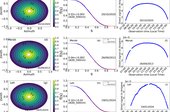 IIA SHANTIKUMAR S. NINGOMBAM
IIA SHANTIKUMAR S. NINGOMBAMSensitivity analysis of aerosol optical and radiative properties over the climate sensitive Hindu Kush Himalayan region using sky radiometer observation
The study examined sensitivity analysis of aerosol optical and radiative properties due to different versions of SKYRAD.pack module (i.e. versions 4.2 and 5.0) along with stability and performance of sky radiometer instruments (POM-01), operating at Hanle, Leh and Merak, located at high-altitude background sites in the most climate sensitive Hindu Kush Himalayan region. The study utilized long-term aerosol measurements during 2008–2024 for examining the stability and performance of the instruments. As a part of sensitivity analysis, coarse-mode aerosol optical depth (AOD) was found to be higher at version 4.2, while fine-mode AOD showed higher at version 5.0, but interestingly the variation of total AOD was found to be insignificant. Further, single scattering albedo (SSA) at version 5.0 was overestimated from 4.2 version. Among the parameters, aerosol asymmetry parameter (AS) showed significantly larger difference between the two versions with overestimation at 4.2 version. Such large differences of AS may be attributed to variations in aerosol radiative forcing parameters. Further, variation of ±2% calibration constants (F0I) in the sensitivity analysis showed significant variation in the retrieval parameters. Aerosol volume size distribution at three sites showed dominantly trimodal pattern at version 4.2, while version 5.0 showed dominance of bi-modal distribution, which may be attributed from significant variation of AS between the two versions. These findings highlighted the importance of performing calibration procedures frequently to ensure the quality controlled data at background sites in particular, and sensitivity analysis for aerosol retrieval parameters in different versions of the SKYRAD.pack software tool.
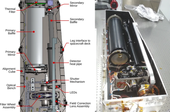 IIA NAGARAJU, K
IIA NAGARAJU, KThe solar ultraviolet imaging telescope on board Aditya-L1
The Solar Ultraviolet Imaging Telescope (SUIT) is an instrument on the Aditya-L1 mission of the Indian Space Research Organization (ISRO) launched on 2 September 2023. SUIT continuously provides near-simultaneous full-disk and region-of-interest images of the Sun, slicing through the photosphere and chromosphere and covering a field of view up to 1.5 solar radii. For this purpose, SUIT uses 11 filters tuned at different wavelengths in the 200 – 400 nm range, including the Mg ii h and k and Ca ii H spectral lines. The observations made by SUIT help us understand the magnetic coupling of the lower and middle solar atmosphere. In addition, for the first time, this allows for the measurements of spatially resolved solar broad-band radiation in the near- and mid-ultraviolet, which will help constrain the variability of the solar ultraviolet irradiance in a wavelength range that is central for the chemistry of ozone and oxygen the Earth’s stratosphere. This paper discusses the details of the instrument and data products.
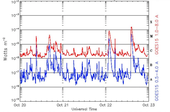 IIA RAVINDRA, B
IIA RAVINDRA, BEvolution of photospheric magnetic field and electric currents during the X1.6 Flare in active region NOAA 12192
The dynamics of magnetic fields in the Sun’s active regions play a key role in triggering solar eruptions. Studies have shown that changes in the photosphere’s magnetic field can destabilize the large-scale structure of the corona, leading to explosive events such as flares and coronal mass ejections (CMEs). This paper delves into the magnetic field evolution associated with a powerful X1.6 class flare that erupted on October 22, 2014, from the flare-rich active region NOAA 12192. We track these changes using high-resolution vector magnetograms from the Helioseismic and Magnetic Imager (HMI) on NASA’s Solar Dynamic Observatory (SDO). Our analysis reveals that a brightening, a precursor to the flare, began near the newly emerged, small-scale bipolar flux regions. During the X1.6 flare, the magnetic flux in both polarities displayed emergence and cancellation. The total current within the active region peaked during the flare. However, it is a non-CME event, and the ratio of direct-to-return current value remains close to 1. The large flare in this active region occurred when the net current in both polarities attained the same sign. This implies that the Lorentz force, a consequence of the interaction between currents and magnetic fields, would have pushed the field lines together in this scenario. This reconnection of opposing magnetic fields is believed to be the driving force behind the major flare in this active region.
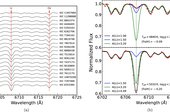 IIA ANOHITA MALLICK
IIA ANOHITA MALLICKHigh lithium abundance connection with the chromospheric helium in red giants: spectroscopic and asteroseismic analyses
We present a study of correlations between high Li abundances and strong chromospheric He i λ10830 absorption-line strengths in Kepler field giant stars. Our sample includes 84 giants with detectable solar-like oscillations in their light curves, and their Li abundances come from the literature or are measured here using LAMOST medium-resolution spectra. Evolutionary phases are determined through asteroseismic analysis, with mixed-mode period spacing (ΔP) used to infer the time evolution of red clump (RC) giants. Near-IR observations of the He i λ10830 line were obtained with the high-resolution Habitable-zone Planet Finder spectrograph on the Hobby–Eberly Telescope. We find high Li abundances and strong He i lines exclusively among RC giants, with their absence in red giant branch stars suggesting a shared origin linked to the He flash. Additionally, a steady decline in He i strength with decreasing Li abundance among RC giants indicates a correlation between these properties. Older, Li-normal RC giants are He weak, while most younger, super-Li-rich giants are He strong, suggesting temporal evolution of both phenomena. We hypothesize that the core He flash and subsequent subflashes may enhance Li abundances in RC giant photospheres and trigger heightened chromospheric activity, leading to stronger He i λ10830 lines in younger RCs. Over time, following He flash, chromospheric activity diminishes, resulting in weaker He i lines in older, Li-normal RCs.
